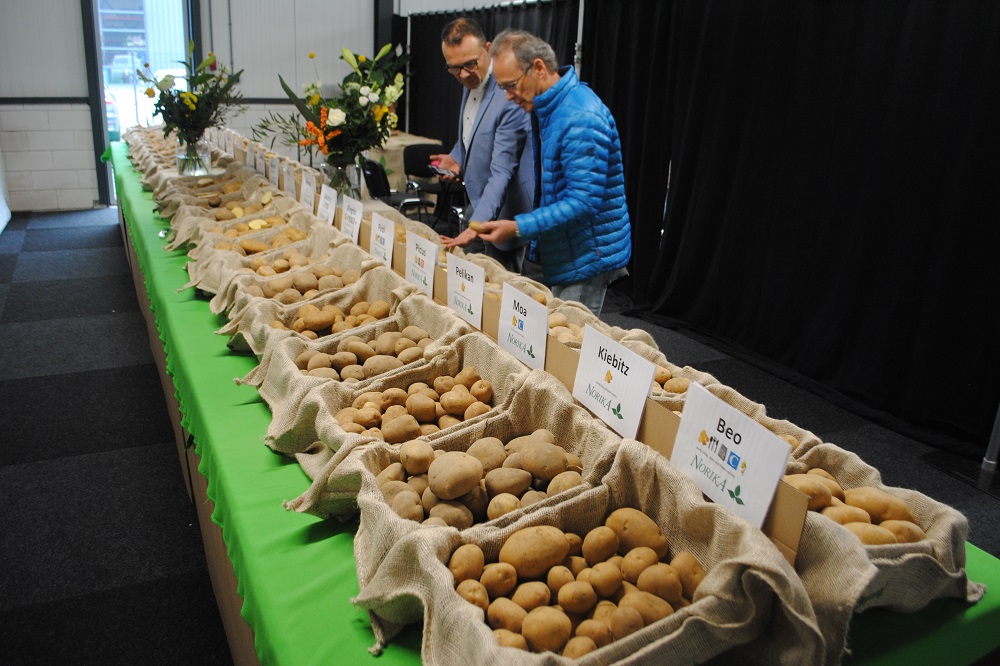Getting a seedling on the variety list as a variety is the dream of many seed potato growers. Registering a new variety is very expensive for small trading houses. That is why it is done deliberately. Once a year, variety shows are organized on a number of days at the beginning of November, mainly concentrated in and around the Noordoostpolder. A moment where seed potato growers from the Netherlands and traders from all over the world can catch up on interesting varieties.
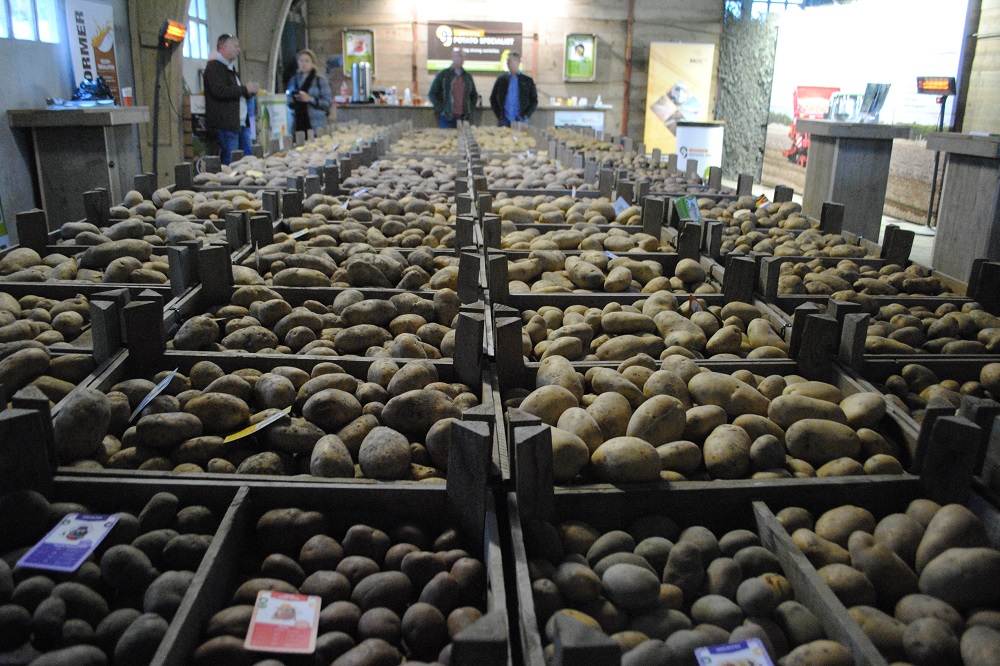
The spotlight is often placed on one or two pots that have been newly registered. It has been somewhat quiet for two years because of corona. That also means two extra years of thinking about which varieties are proposed by the trading houses. Akkerbouwkrant made a round of various shows of ‘small trading houses’ and noted a trend. After such a season with a lot of phytophthora, the main focus is on tolerances and resistance. In two parts, we present you the most important findings of the 11 trading houses with which the arable newspaper has entered into discussion.
Germicopa
Area manager Harry van de Vijver of the French Germicopa will highlight the Decibel variety at the display in Beach Club Lemmer. A table potato, which can also be cooked with the skin on. “A consumer variety with above-average resistance to the most common diseases. It is a stable variety, which has proven its potential in recent years with the drought. But also this season, with completely different conditions, Decibel remained stable in yield and properties. It is a fairly straight forward breed with no real slips.”
According to Van de Vijver, Decibel is not yet grown in the Netherlands, but it is a very interesting variety. Catimini is a variety with a high tuber setting and sees Van de Vijver as a real counterpart to the Hanza. “A small field crop, but there are just forty tubers per bush. Catimini has a dark yellow flesh color. It is also a variety where we are running a trial crop in Belgium for the processing industry. The variety is now harvested in the barn and will be processed in November. The first factory is very satisfied.”
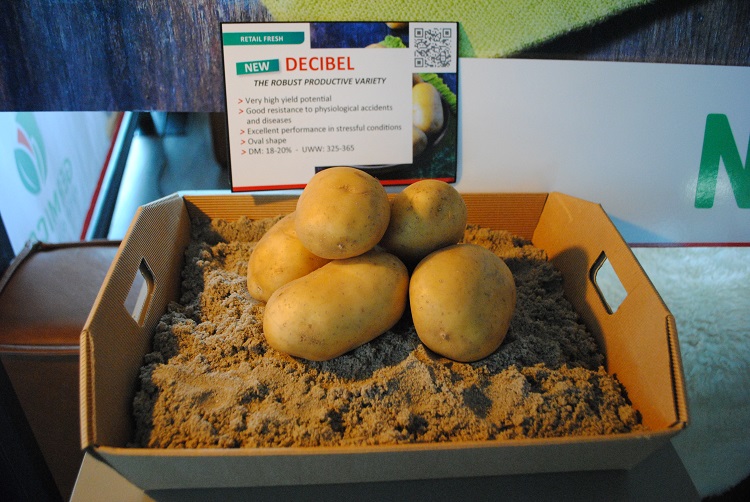
Luneba is a new starch variety where Germicopa has started a trial cultivation for processing into flakes. In particular, the resistance to wart disease, the high tuber yield and the high to very high starch content means that the Luneba is being pulled hard.
planter
Vitabella is the main variety of potato trading house Plantera from Marknesse, but the Sherman and Vicenta are relatively new varieties that are also in the spotlight. “Sherman is a ‘baker’, who is highly valued for taste. Virus resistance, yield and peel quality are also important breeding aspects. It is a breed that needs to manifest in the UK. It is not easy to get the breed there because of Brexit. That’s difficult. At the moment, about five hectares are being cultivated and 100 tons are coming onto the market. That is a good level for a new variety,” says Plantera director Gerard Bovée.
Vicenta is an early bulk variety, which becomes coarse very quickly and thus produces large tubers. “Because the potato gives an enormous yield in a short time, it does not have to be in the field for long. It is a strong plant that also grows with shade on the ground and less water. With a view to sustainability, this is an interesting variety.” Bovée states that the two new varieties fit in well with Plantera’s philosophy. “We focus on varieties that have a low input and which also require fewer pesticides. That is interesting for organic, in our view a growth market. Resistant varieties are also interesting for conventional cultivation. You only have to spray once, that makes a difference.”
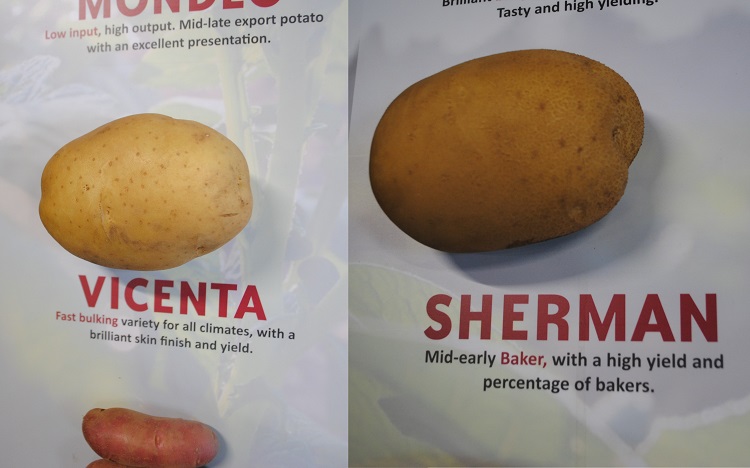
TPC
Jos Bus, agronomist at The Potato Company (TPC), brings out seedling WW14-174. A variety that has the entire range of AM resistance and for wart diseases. Three French fries manufacturers process the long oval potato, which falls into the Innovator segment and also resembles it in terms of skin and length. “With an average yield of ten tons, it is fifteen percent higher. This one is a bit whiter in color. For two years we have tested the seedling without sprouting inhibition and it holds up completely in terms of baking quality. When reconditioning in cold storage, the cold sugars are removed.”
TPC hopes to introduce the variety in the coming year. “It is quite a unique seedling. It is expected that doors will be opened with the storage properties. A saving of two to three cents per kilo on cooling costs. What is also important is that no residue is found, which makes the German market interesting. We have put a stop to the last two years and therefore have not registered the number yet. This has had the advantage that we have become even more convinced. We think the seedling has more to offer than Innovator because it can be grown in more areas. In terms of yield, our seedling is at least competitive or even better. Ultimately, money has to be made.”
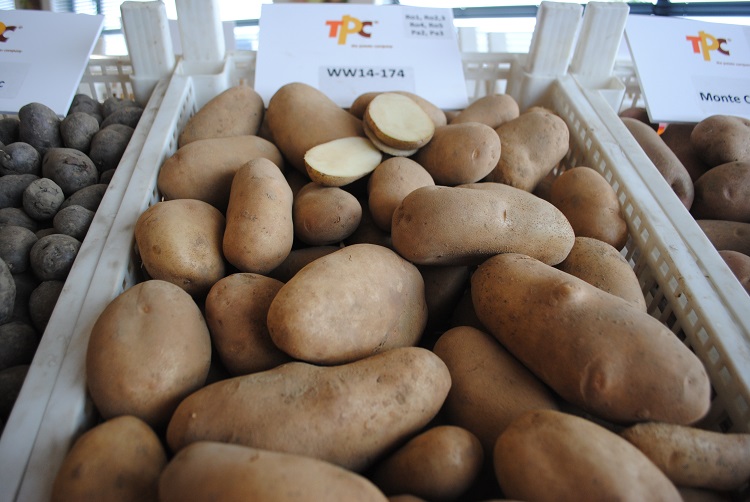
agricultural plant
“One drawback, Red Sky is red-skinned.” Product manager Gerard Schenk of Agroplant can name few disadvantages of the new potato chip variety. Red Sky was registered this year, making it the first potato variety with which the potato trading house from Medemblik enters the market. “A big advantage is the ninety growing days to a good underwater weight. Red Sky can therefore be chipped early in the season. In Greece, for example, such an early variety is in great demand. Furthermore, the potato is easy to store, it has good dormancy and good baking properties.
We have high hopes for it. Since it is our first potato chip, it is all the more fun to introduce the variety.” AgroPlant has a pool of growers where they can sell the variety. “Now we’re really going to build up. We want to scale up in terms of seed potato area every year in two or three years, so that we can have good production in the third or fourth year, and can supply various customers.”
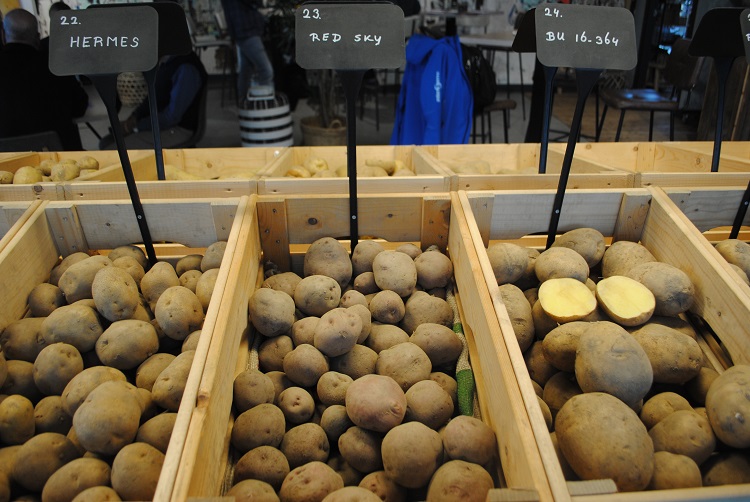
The Nijs
The medium-early chip variety Hind is a spearhead for De Nijs from Warmenhuizen. A potato that, according to product manager Jan-Paul Bandsma, grows all over the world. “From Sweden to Uruguay and even in Africa. Africa and the Mediterranean areas are looked at as an export market. It is a large potato from which good chips can be cut. So a home fries, but otherwise very versatile.” The planting material is grown in the Netherlands and then exported. “In the field, we notice how robust the variety is. Hind has a low nitrogen requirement and a strong root system. The variety just keeps going and keeps good yields.”
Bandsma: “As a small trading house you have to make conscious choices. Hind has proven itself well at trial field level, but we still waited quite a while to register the variety. High-quality starting material is expensive and registering a new variety is not a cheap affair either.”
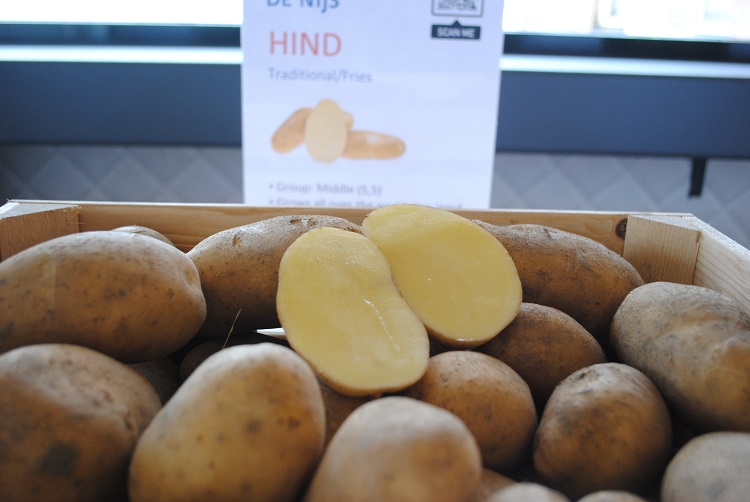
Geersing Potato Specialist
With forty hectares, the phytophthora-resistant French fries variety Cammeo is the flagship in the range of Geersing Potato Specialist from Emmeloord. The medium early coarse light yellow table potato variety Camillo is new in the assortment and the ‘baby’ of Cammeo. “An export variety, but perhaps also for the Dutch market,” thinks Marcel Geersing. “It is one of the strongest phytophthora-resistant varieties. BioNext gave Camillo a 9.5 in field trials with robust varieties. Camillo is also doing well against scabies. Actually all the qualities that Cammeo also has, only that breed is more of a French fries. Camillo is more waxy. The variety can grow considerably in the organic sector.”
Peter Pan is another ware potato in which Geersing Potato sees great potential. Mainly because of the Phytophthora resistance based on the R8 gene, the variety is very interesting for the organic sector. “The yellow-fleshed potato has a very good taste,” says Jan-Eric Geersing. “Peter Pan boils very firm, with a decent dry matter content. The breed also has a high percentage of bantam tubers. Because of the big eyes, there was some doubt, but maybe it can be something. The breed has yet to be registered.”
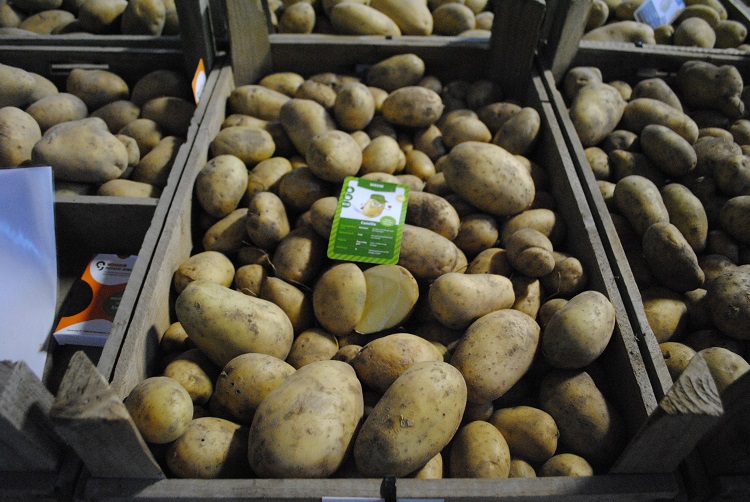
Den Hartigh
For Matthijs Kloek van Den Hartigh, the long-oval white-fleshed King Russet deserves a place in the spotlight. The variety has various resistances (ABCDE and wart disease 1 and 6) and the ideal shape for French fries. “The potato can be stored very well and has a high dry matter content on all soils,” he points out. Edison is a newcomer to Den Hartigh. The French fries and table potato variety performs well in a changing climate.
“The variety can withstand drought well and maintains a high yield even without watering. Edison also has good storability and is strong against Y virus. We currently have about twenty hectares of Edison’s seed potatoes. We are fully under construction, but notice that there is a lot of demand for this relatively young variety.
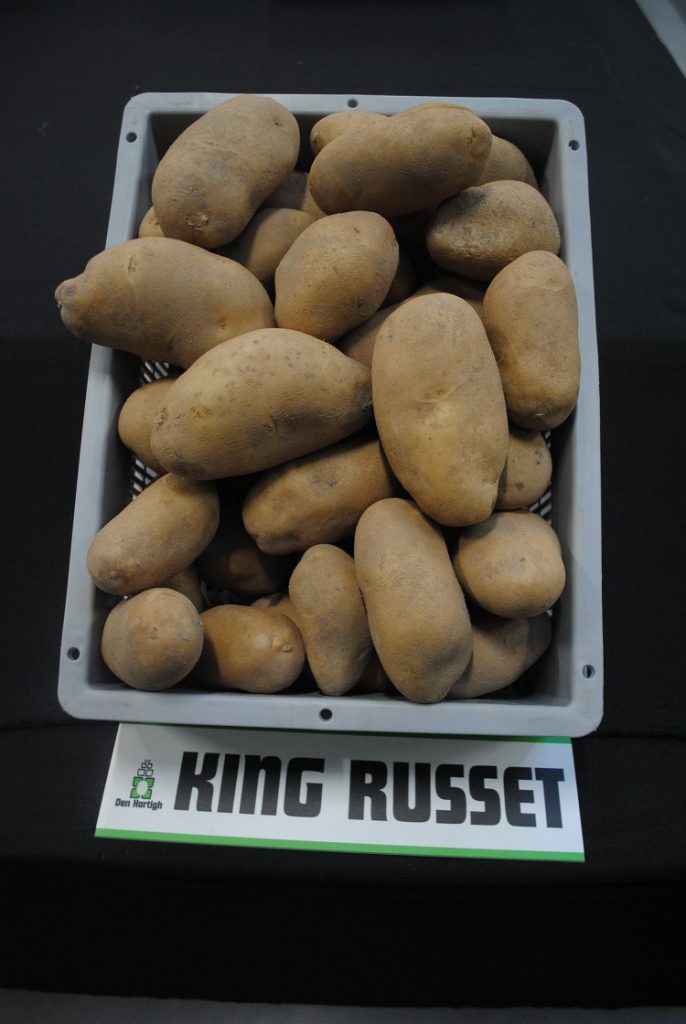
Meijer Potato
Meijer Potato has new potato chips, chips and table potato varieties. Lady Alicia is a promising potato chip variety. The potato has strong plants that withstand stress periods well and gives high yields. According to international sales manager Erik Oggel, Lady Alicia has a high dry matter content in the tuber, is nicely uniformly round and not sensitive to blue. “Growers are very satisfied with it. In the factory, Lady Alicia shows good texture, good efficiency and high underwater weight.” Lady Jane is a new French fries variety.
“An Agria hybrid with a beautiful yellow flesh color and phytophthora resistance. It is an easy-to-grow potato, which has also come through well this season. The underwater weight is higher than Agria. The yield is the same, only less excess and hollow hearts. We are building the breed considerably.
Sound and Acoustic are the two new table varieties from Meijer Potato. “Acoustic is a medium-early variety with phytophthora resistance. The potato is easy to wash, needs at least 25 percent less nitrogen, fast foliage development and high yields, both on light and heavier soil.” Sound is a versatile robust potato with a high quality and also phytophthora resistance. Oggel: “The yield potential is fantastic. With Sound you can go in multiple directions, both in the traditional market and the retail segment. The potato has long oval tubers with a nice skin.”
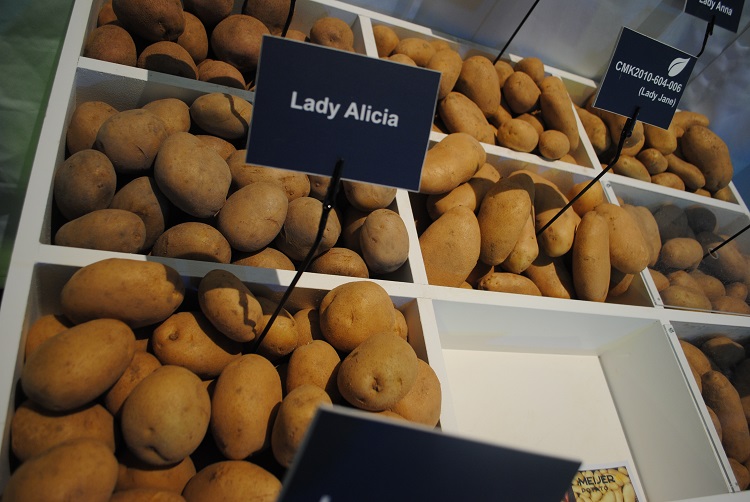
With a view to the near future, in which sustainable potato cultivation will become increasingly important, Meijer Potato is focusing on these new robust varieties. “Varieties with a stable high marketable yield, which use scarce agricultural land, water and other natural resources more efficiently. In addition, varieties that produce stably in a changing climate and can be grown in different countries, and varieties that require less plant protection products and fertilizers.”
Royal ZAP/ Semagri
The consumption variety Dunastar and the starch potato Saprodi are put in the spotlight by Royal ZAP/Semagri. “Dunastar is a red-skinned potato that can be sold widely. The breed is strong on virus. Dunastar does very well in storage, as the variety has a very long dormancy period. The yields are high. There is an average of thirteen to fifteen tubers under the plant,” Dirk van Dijken of Royal Zap explains the technical aspects of cultivation. “The yellow-fleshed potato is also very popular, especially because of its good taste.” In 2021, approximately 28 hectares of seed potatoes of the variety have been cultivated. The intention is to grow to fifty hectares.
According to Jarke Kruize of Semagri, Saprodi is ‘by far the largest starch and flake variety’. “With an average of twenty tons of starch per hectare, we can go through that on trial fields,” he points out. “The variety has broad resistance to, among other things, palida and wart diseases. What is a big advantage is the smooth initial development. Saprodi comes up quickly, with lots of foliage that serves as ground cover. The harvestability is very good. With low susceptibility, this variety is very interesting for seed potato cultivation. The seed potatoes are grown throughout Europe.
In the Netherlands now a small 420 hectares and that is quite decent. Semagri started in 2010 with 40 hectares of seed potatoes. That is now 1350 bunder and so Saprodi is by far the largest variety.”
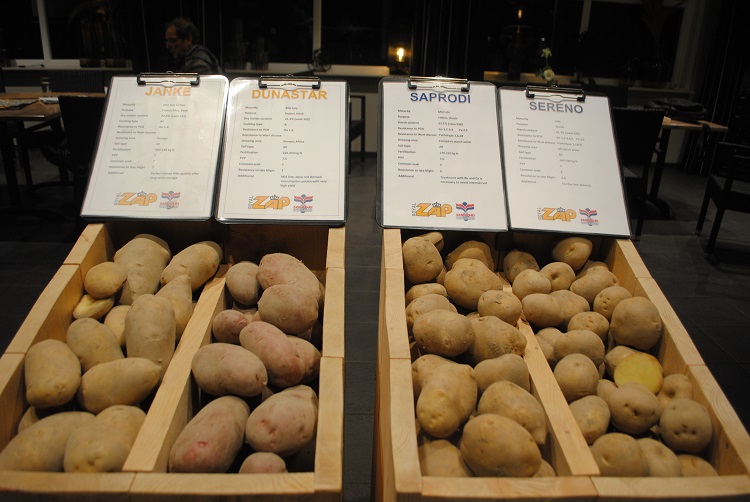
Europlant
Ivetta is a very interesting slightly floury ware potato in the Europlant package. Due to the very broad nematode resistance, the variety is also classified as a medicine on an infected plot. “After planting Ivetta, everything was cleaned up one hundred percent, it was clean when planted,” says production manager Cees Kranenburg of Europlant Aardappel bv. “But we are actually doing the variety short if we only focus on this. The yellow-fleshed potato has a smooth skin with flat eyes and good taste.”
Venezia is a table potato that Kranenburg considers for a moment. “Thanks to the smooth skin and the deep yellow flesh color, this potato has a wonderful appearance. Venezia also has a high yield, a high tuber number and is good for virus. Because we are allowed to use fewer resources, this has become a real problem in recent years. Thanks to the beautiful breeding in this variety, you have good virus resistance.” Kranenburg also highlights the table potato variety Regina (“Perhaps the very highest yield. A robust variety that just keeps on growing”), Ricarda (“A red-skinned ware potato for virtually every destination”), Allians (“An organic solid tube with a good taste”) and Etana (“The chips potato is the new standard for sustainable cultivation”).
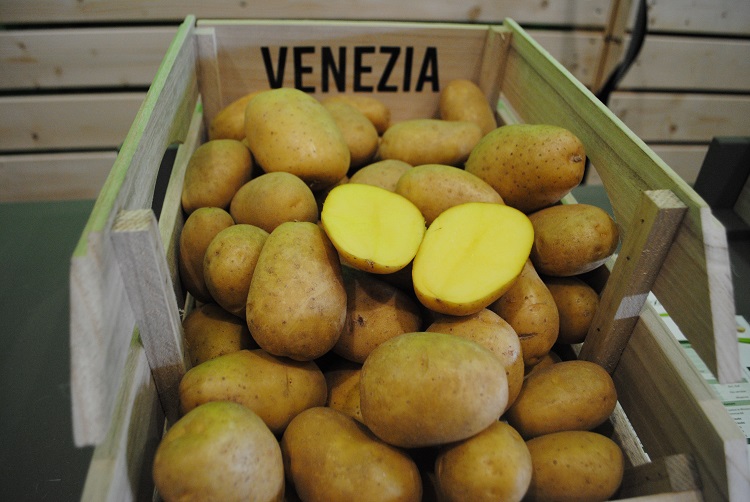
Interseed Holland
Francis is a new commercial variety from Interseed Holland. According to area manager Arie van der Spek, this may well be the promising successor to Zorba, the largest variety of the potato trading house from Dronten. “Francis is a very early chip variety with a light flesh colour. Due to the long to long oval tubers and the fact that the potato has a high underwater weight early on, this variety is very suitable for early processing. Francis will be available from mid-July, just before the Zorba arrives. That is why Francis will be a good addition to Zorba and may even take over part of this market.
” According to Van der Spek, Travis is a talent in the ‘Fontane segment’. “This variety is a bit coarser, but better in underwater weight and can withstand drought well.”
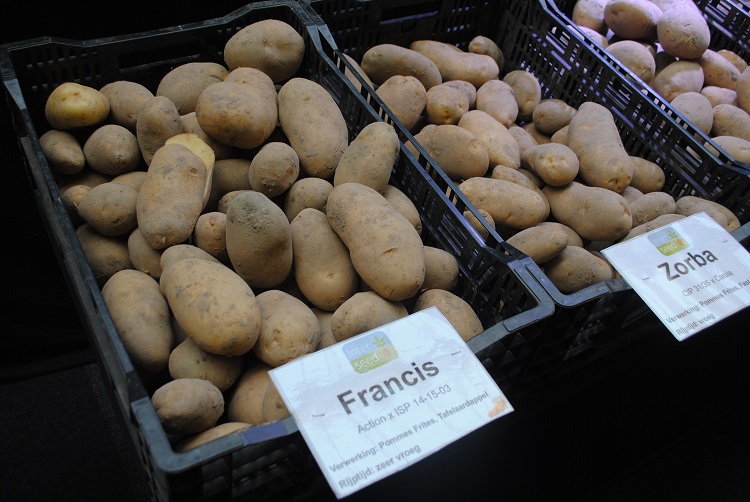
The French fries variety Alanis is highlighted by Van der Spek because of its strong tolerance against phytophthora. “Alanis also needs very little nitrogen. We have already been asked by one of the largest chip processors whether they can have the exclusive right from Alanis.” According to Van der Spek, there is also great (renewed) interest from other professional processors. “Really a breed for the future.”
This is an article from the Akkerbouwkrant. Do you want to receive this at home? Click here.

